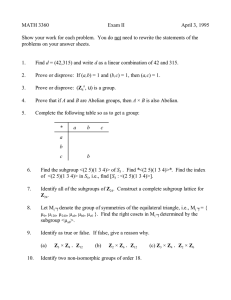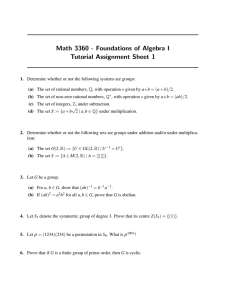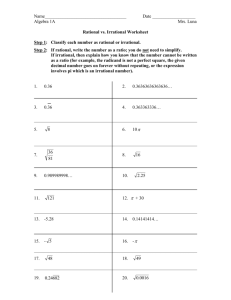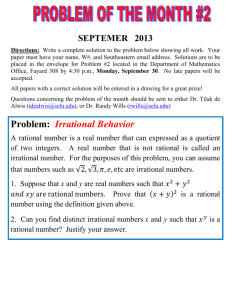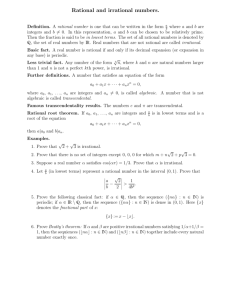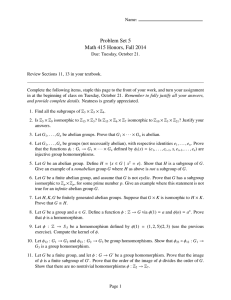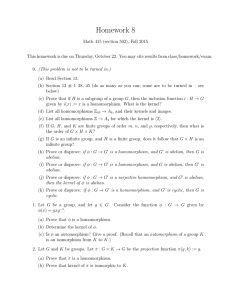MATH 3360 Final Exam May 8, 2000
advertisement
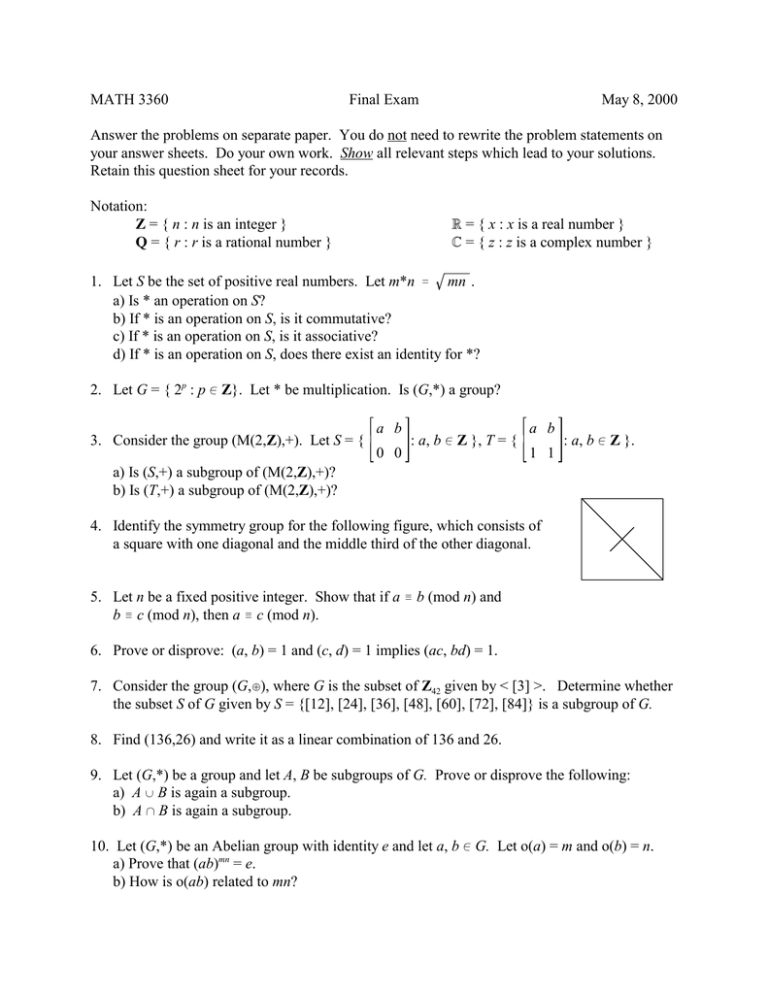
MATH 3360
Final Exam
May 8, 2000
Answer the problems on separate paper. You do not need to rewrite the problem statements on
your answer sheets. Do your own work. Show all relevant steps which lead to your solutions.
Retain this question sheet for your records.
Notation:
Z = { n : n is an integer }
Q = { r : r is a rational number }
ß = { x : x is a real number }
Ü = { z : z is a complex number }
1. Let S be the set of positive real numbers. Let m*n ' mn .
a) Is * an operation on S?
b) If * is an operation on S, is it commutative?
c) If * is an operation on S, is it associative?
d) If * is an operation on S, does there exist an identity for *?
2. Let G = { 2p : p 0 Z}. Let * be multiplication. Is (G,*) a group?
3. Consider the group (M(2,Z),+). Let S = {
a b
0 0
: a, b 0 Z }, T = {
a b
1 1
: a, b 0 Z }.
a) Is (S,+) a subgroup of (M(2,Z),+)?
b) Is (T,+) a subgroup of (M(2,Z),+)?
4. Identify the symmetry group for the following figure, which consists of
a square with one diagonal and the middle third of the other diagonal.
5. Let n be a fixed positive integer. Show that if a / b (mod n) and
b / c (mod n), then a / c (mod n).
6. Prove or disprove: (a, b) = 1 and (c, d) = 1 implies (ac, bd) = 1.
7. Consider the group (G,r), where G is the subset of Z42 given by < [3] >. Determine whether
the subset S of G given by S = {[12], [24], [36], [48], [60], [72], [84]} is a subgroup of G.
8. Find (136,26) and write it as a linear combination of 136 and 26.
9. Let (G,*) be a group and let A, B be subgroups of G. Prove or disprove the following:
a) A c B is again a subgroup.
b) A 1 B is again a subgroup.
10. Let (G,*) be an Abelian group with identity e and let a, b 0 G. Let o(a) = m and o(b) = n.
a) Prove that (ab)mn = e.
b) How is o(ab) related to mn?
11. Let G = M(9) and let H = < µ 270 >. Find [G : H ].
12. Find the subgroup lattice for:
a) M().
b) Z24
13. Let be a group homomorphism, : G 6 H, and let a 0 G. Show that (a -1 ) = (a) -1.
14. Determine whether the following pairs of groups, with addition as the operation in each case,
are isomorphic or not (prove or disprove).
a) Z5 × Z10 and Z50
b) Z and E, where E is the set of even integers.
15. Find the smallest subring of Q which contains ½.
16. Verify that Z2 × Z3 is not an integral domain.
17. Let D be a well-ordered integral domain. Let a 0 D and suppose that both a ú 0 and a ú e,
where e is the unity of D. Prove that a2 > a.
18. Consider M(2,Z). Let B =
1 0
. Consider the mappings , µ as mappings from the
&1 0
additive group M(2,Z) to the additive group M(2,Z) where is given by (A) = BA for A 0
M(2,Z) and µ is given by µ(A) = AB for A 0 M(2,Z). Find ker( ) and ker(µ).
19. For each of the following give an example which satisfies the condition if such an example
exists; if no example exists, explain why.
a) rational + rational = irrational
b) irrational + irrational = rational
c) irrational + rational = rational
d) irrational + rational = irrational
20. For z 0 Ü let (z) ' z̄ . Show that is a ring isomorphism of Ü to Ü.
21. Let n be a fixed positive integer and Tn be the set of nth complex roots of unity, i.e., Tn =
2 k
2 k
{z = cos (
) + i sin(
) : k 0 Z }. Show that Tn with multiplication as its operation is a
n
n
group.
22. Let G and H be groups and let be a homomorphism which maps G onto H. Prove or
disprove the following:
a) H is Abelian implies G is Abelian.
b) G is Abelian implies H is Abelian.
